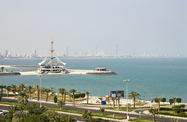A solid performance from the non-oil sector and increased state spending are forecast to drive economic growth in Bahrain above both regional and global averages this year, though falling oil prices and rising debt levels could impact expansion in 2015.
In its latest global economic outlook, released on October 7, the IMF projected that Bahrain’s economy would expand by 3.9% this year, well above the 2.7% predicted for the broader Middle East.
Though the IMF’s growth forecast is stronger than the regional average, it does indicate a slowing of the economy, which expanded by 4.9% in 2013, according to the fund’s estimates. This trend is expected to continue into 2015, with the IMF forecasting GDP to increase by a more moderate 2.9% next year.
Growth is forecast to keep a steady pace through to 2019, with expansion set to be 3.3%. This slightly decelerated rate of growth sits in the context of the fund’s expectations for the Middle East in general, with regional GDP set to rise by 3.9% in 2015 and 4.6% by 2019.
The IMF’s projections could come up slightly short, however, if indications from the economy’s performance in the second quarter are anything to go by. Data issued by the statistics agency, the Central Informatics Organisation, in September showed year-on-year (y-o-y) growth was 7% at current prices, with the construction, transport, communications and financial services sectors all expanding well above the IMF’s forecast rate. The hydrocarbons sector posted growth of 9.3% y-o-y, though it was coming off a low base in the second quarter of 2013, when significant portions of production capacity were out of service due to maintenance.
Infrastructure lift
Some of the forecast growth in the coming year will be generated by a stepping up of state-backed infrastructure development, with the government allocating up to $4.4bn for major capital works, coming both from direct budgetary allocations and funds provided by the GCC.
According to Kamal bin Ahmed, the minister of transport and the acting chief executive of the Economic Development Board, the heightened infrastructure spending will supplement existing growth levels and also strengthen the economy’s base for longer-term development.
“This will not only act as an immediate stimulus, but also help to put in place the infrastructure that will support long-term growth,” he told Bloomberg in September. “For example, the development of the GCC railway and the investment in Bahrain International Airport will help to improve our already strong connectivity with our GCC neighbours.”
Debt shadow
While the government is planning to boost capital works spending, it will be wary of adding too much to its existing debt stock, which has grown in recent years. Debt levels rose to $13.2bn, representing 44% of GDP at the end of 2013, up from 36% in 2012, with further debt-funded spending having the potential to push this close to 50% of GDP this year. Higher spending across the 2013 fiscal year left Bahrain with a $1.1bn budgetary deficit, and with additional outlays planned this year and next, this could rise further.
While debt levels are seen as a problem, ratings agency Moody’s has said the government has shown it is determined to improve its financial position. In a report issued in late September, the agency said that while Bahrain faced various challenges, including the limited scope for additional revenue generation and popular pressure to increase current spending, the government’s renewed commitment to reinforcing fiscal balances should lead to gradual improvement.
Among the positives cited by Moody’s in its investor note were the return to profit of government investment fund Mumtalakat and a strengthening of the domestic banking sector, which had its outlook upgraded from negative to stable by the agency in March.
On the other side of the ledger, Moody’s said that limitations to local oil production meant Bahrain would be restricted in boosting revenue from that source, which accounted for 85.6% of total state income last year.
That ledger could see more red ink in the coming year with the steady easing of oil prices, which by mid-October fell to below $90 a barrel, a four-year low. With some estimates putting the break-even point for Bahraini oil at $116.40 for next year, the government could be faced with a widening gap in its budget revenues in 2015 unless there is a significant rebound in the global market. However, with forecasts for prices to remain flat or even retreat further by 2016, Bahrain may not be able to rely on its modest oil production to bridge its budgetary deficit.

